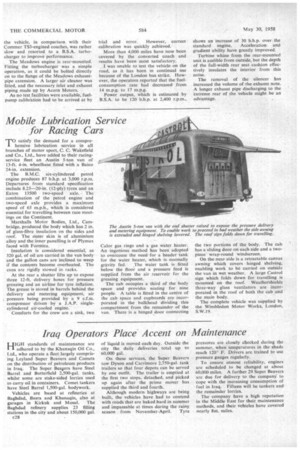Mobile Lubrication Service for Racing Cars
Page 66

If you've noticed an error in this article please click here to report it so we can fix it.
" satisfy the demand for a compre rhensive lubrication service in all branches of motor sport, C. C. Wakefield and Co., Ltd., have added to their racingservice fleet an Austin 5-ton van of 13-ft. 4-in, wheelbase fitted with a Baico 24-in. extension.
The B.M.C. six-cylindered petrol engine produces 87 b.h.p. at 3,000 r.p.m. Departures from standard specification include 8.25-20-in. (12-ply) tyres and an Eaton 13500 two-speed axle.. The combination of the petrol engine and two-speed axle provides a maximum speed of 65 m.p.h., which is considered essential for travelling between race meetings on the Continent.
Marshalls Motor Bodies, Ltd., Cambridge, produced the body which has 2 in. of glass-fibre insulation on the sides and roof. The outer skin is of aluminium alloy and the inner panelling is of Plymax faced with Formica.
Insulation is considered essential, as 320 gal. of oil are carried in the van body and the gallon cans are inclined to weep if the contents become overheated. The cans are rigidly stowed in racks.
At the rear a shutter lifts up to expose three 12-ft. delivery hoses for pressure greasing and an airline for tyre inflation. The grease is stored in barrels behind the delivery and metering equipment, air . pressure being provided by a 9 c.f.m. compressor driven• by a J.A.P. singlecylindered air-cooled engine.
Comforts for the crew are a sink, two Calor gas rings and a gas water heater. An ingenious method has been adopted to overcome the need for a header tank for the water heater, which is normally gravity fed. The water tank is fitted below the floor and a pressure fee' d is supplied from the air reservoir for the greasing equipment.
The cab occupies a third of the body space and provides seating for nine people. A table is fitted in the centre of the cab space and cupboards are incorporated in the bulkhead dividing this compartment from the remainder of the van. There is a hinged door connecting the two portions of the body. The cab has a sliding door on each side and a twopiece wrap-round windscreen.
On the neap side is a retractable canvas awning which covers hinged shelving, enabling work to be carried on outside the van in wet weather. A large Castrol sign which folds down for travelling is mounted on the roof. Weathershields three-way glass ventilators are incorporated in the roof of both the cab and the main body.
The complete vehicle was supplied by the Wimbledon Motor Works, London, S.W.19.




























































































































